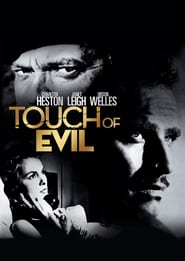
For me, a film made by one of classic Cinema’s great auteurs and made in the great “Film Noir” style , is one of those must see works of art. Orson Welles made one of the greatest films of all time with his very first movie and “Citizen Kane”, still resonates today in its magnificence. The problem with starting at the top, which he did with that film, is that there is nowhere else to go but down. Since Kane, Welles has created many great films but in general each one has been less than its predecessor, until 1958, when he filmed, quite by accident, his Ode to Noir and classic Hollywood Cinema. The result is, “Touch of Evil”, in which Charlton Heston plays a Mexican hero and Wells himself plays an American villain. If ever there was a movie where the visual envelops and controls the story, then “Touch of Evil” is that film. Chock full of some the most spectacular visual set pieces ever filmed, the movie is based on a hole-ridden and convoluted plot. Its magnificence is that a person can watch it, become enthralled by it, while never paying much attention to its plot. The film’s opening sequence is an unforgettable Mise-en-scene extravaganza that introduces to the audience, at the same time, the background and the plot’s main driving force within three minutes of a long tracking shot. This rightly celebrated shot is located at a small Mexican – American border area and ends with a murderous explosion that the audience is waiting to happen from almost the moment the film begins. Through it all we see two main characters and come to recognize the area that the film takes place in. It is also one the greatest examples of pure suspense as the viewing audience knows what is about to occur waiting for the payoff that takes an agonizing three minutes while following along the happy lovers of two main characters in the film. This opening scene while probably the most celebrated in the film, is not alone in its visual delight as the movie keeps rewarding its viewers with many more glorious set pieces. The opening scene ends in an explosion of a car that kills its two occupants on the American side of the border, set by dynamite placed in the car on the Mexican side. The shot also tracks Mexican Drug enforcement officer Vargas (Charlton Heston who plays a Mexican in a curious understated performance) walking across the border with his newlywed American bride Suzy (Janet Leigh). Orson Welles plays the corrupt aging American Police chief of the border area (Hank Quinlan). Welles takes great pleasure in his performance, exaggerating the captain’s look by adding padding to his already hefty frame. Quinlan mumbles his lines and Welles adds a vicious squinted stare in everything he says that instills fear in the hearts of all around him. His evil aura glares out of the screen and it results in one of Cinema’s great villainous roles. The only person who is not intimidated by him is Vargas who discovers that Quinlan is being paid off by the Mexican drug mob that he is trying to put away. Suzy becomes the innocent victim in this battle of strong personalities. Welle’s camera work mesmerizes with its consistently changing viewpoints. While it follows a character it stops and pays attention to other characters lurking in the shadows. It is an ingenious technique that kept me on high alert throughout the movie. Important supporting characters have strong influences in the proceedings. There is Akim Tamiroff as the sleazy sweaty drug boss Joe. The immortal Marlene Dietrich as the owner of the Mexican whore house and Quinlan’s ex flame. She serves as a sort of window into Quinlan’s past and soothsayer to his future. One of the more interesting character’s is the motel night manager (Dennis Weaver), who’s creepy psychotic tameness foresees Norman and the Bates Hotel from Hitchcock’s horror masterpiece, “Psycho”. Hitch borrowed a lot from this film in making his movie only two years later. The mannerisms of the two characters are eerily similar. The film ends with another great tracking shot whereby Quinlan confesses his crimes to his closest confidant Pete (Joseph Calleia), who in turn is bugged by Vargas who has to stay close in order to connect the recording. The scene has a spanning scene of depth that follows all three characters closely. It is another visually stunning scene of power. The only negative about the film is the convoluted script that includes some fairly unbelievable plot holes, such as suspending belief that Suzie could be capable of strangling the brutish Joe or that anyone would believe that she would be able to do that. Leigh’s character Suzy also shows off real stupidity in her actions when dealing with the drug gangsters. Her lack of fear and scornful behaviors also begs of disbelief. When Welles took on the project it was a B grade crime thriller and he re-wrote the entire script adding all the visual flair and style to the ordinary crime driven plot and as a result produced a visually stunning Noir masterpiece that never gets boring no matter how many times it is viewed. It has influenced countless films that have come after it from the aforementioned Psycho to the Coen Brothers, “Miller’s Crossing”. It is a visual over substance tour de force and one of the great Orson Welle’s best films.

